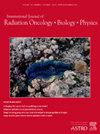Early Assessment of Response Using ctDNA as a Non-Invasive Biomarker in Patients with Gynecologic Malignancies Undergoing Radiotherapy
IF 6.4
1区 医学
Q1 ONCOLOGY
International Journal of Radiation Oncology Biology Physics
Pub Date : 2024-10-01
DOI:10.1016/j.ijrobp.2024.07.013
引用次数: 0
Abstract
Purpose/Objective(s)
Radiotherapy (RT) causes toxicity and outcomes of treatment may not be known for months post-therapy. Early identification of response with a ctDNA blood draw may provide a non-invasive way to predict response to treatment. In this study, we used ctDNA to assess response to RT in patients with GYN cancers as early as mid-way during treatment.
Materials/Methods
After IRB approval, patients with vulvar, cervical, and recurrent endometrial cancer were treated with RT at our institution between 2022 and 2024. The ctDNA was obtained using personalized molecular residual disease assay pre-RT, mid-way through RT, pre-boost with brachytherapy or SBRT, at the end and in follow-up at 1, 3, 6, and every 6 months -post RT, respectively. A detectable value of ctDNA was defined as any level above 0.00 mean tumor molecules (MTM)/mL, whereas 0.00MTM/mL was undetectable. During and after RT, ctDNA of 0.00MTM/mL was defined as complete metabolic response (cMR) but a reduction without achieving the value 0.00MTM/mL in ctDNA was deemed partial metabolic response (pMR). Correlation between ctDNA levels and imaging (PET-CT, MRI, and CT) was also assessed. Statistical analyses used were descriptive statistics, t-test, Chi-square test and a spearman-rank correlation coefficient (ρ).
Results
A total of 105 serial ctDNA blood draws were obtained from 21 patients with 8 (38%) vulvar, 7 (33%) cervical, 2 (10%) neuroendocrine, and 3 (19%) recurrent endometrial cancers (reEMCa). Median age was 59 years (range = 35-90 years). Median number of ctDNA draws per patient was 6 (range = 1-9). Median radiation dose was 5900 cGy (range = 4500-7000 cGy), brachy boost of 28 Gy/4 fx T&O and SBRT 30 Gy/5 fx for 7 cervix cases, and SBRT boost 2750 cGy/5 fx for reEMCa. There was 100% reduction in ctDNA values (metabolic response) from pre-to post-RT (mean = 2.04 vs. 0, P = 0.03): 75% cMR and 25% pMR. In patients who sustained response to RT, mid- and end-RT ctDNA draw exhibited 0.00MT/ml (undetectable), which continued in follow-up. A strong correlation was observed between elevated ctDNA and SUV/measurable disease on imaging pre-treatment (ρ = 0.64, P = 0.01), as well as undetectable ctDNA and decline of SUV/complete resolution of SUV at 3-6 months following RT (P = 0.045).
Conclusion
The ctDNA in patients with gynecological malignancies drawn at pre-, mid- and post-RT sustained metabolic response and correlated with response to treatment by imaging and clinical examinations. Our early findings suggest that a mid-treatment ctDNA test identified responders to RT and thus may serve as an early predictive biomarker of response. A larger prospective evaluation is warranted.
将ctDNA作为接受放疗的妇科恶性肿瘤患者的非侵入性生物标记物,对反应进行早期评估
目的/目标:放疗(RT)会产生毒性,治疗结果可能在治疗后数月才能知晓。通过ctDNA抽血及早确定反应可提供一种预测治疗反应的非侵入性方法。在这项研究中,我们使用ctDNA评估了妇科癌症患者在治疗中期对RT的反应。材料/方法经IRB批准后,外阴癌、宫颈癌和复发性子宫内膜癌患者在2022年至2024年期间在我院接受了RT治疗。分别在RT前、RT中途、近距离放射治疗或SBRT增强治疗前、RT结束时以及RT后1、3、6个月和每6个月的随访中使用个性化分子残留病检测方法获取ctDNA。可检测到的ctDNA值定义为任何高于0.00平均肿瘤分子(MTM)/毫升的水平,而0.00MTM/毫升为检测不到。在 RT 期间和 RT 结束后,ctDNA 达到 0.00MTM/mL 定义为完全代谢反应(cMR),但未达到 0.00MTM/mL 的ctDNA 降低值则被视为部分代谢反应(pMR)。还评估了ctDNA水平与影像学(PET-CT、MRI和CT)之间的相关性。采用的统计分析方法包括描述性统计、t 检验、卡方检验和矛人秩相关系数 (ρ)。结果 21 名患者共抽取了 105 份连续的 ctDNA 血液,其中 8 人(38%)为外阴癌,7 人(33%)为宫颈癌,2 人(10%)为神经内分泌癌,3 人(19%)为复发性子宫内膜癌(reEMCa)。中位年龄为 59 岁(35-90 岁)。每位患者的ctDNA抽取次数中位数为6次(范围=1-9)。中位放射剂量为5900 cGy(范围=4500-7000 cGy),其中7例宫颈癌患者使用了28 Gy/4 fx T&O和30 Gy/5 fx SBRT增强疗法,再EMCa患者使用了2750 cGy/5 fx SBRT增强疗法。ctDNA值(代谢反应)从RT前到RT后减少了100%(平均值=2.04 vs. 0,P=0.03):75% cMR 和 25% pMR。在对RT有持续反应的患者中,RT中期和末期的ctDNA抽样显示为0.00MT/ml(检测不到),这种情况在随访中持续存在。ctDNA的升高与治疗前影像学检查的SUV/可测量疾病(ρ = 0.64,P = 0.01)以及RT后3-6个月检测不到ctDNA与SUV下降/SUV完全消退(P = 0.045)之间存在很强的相关性。我们的早期研究结果表明,治疗中期的ctDNA检测可识别RT反应者,因此可作为反应的早期预测生物标志物。有必要进行更大规模的前瞻性评估。
本文章由计算机程序翻译,如有差异,请以英文原文为准。
求助全文
约1分钟内获得全文
求助全文
来源期刊
CiteScore
11.00
自引率
7.10%
发文量
2538
审稿时长
6.6 weeks
期刊介绍:
International Journal of Radiation Oncology • Biology • Physics (IJROBP), known in the field as the Red Journal, publishes original laboratory and clinical investigations related to radiation oncology, radiation biology, medical physics, and both education and health policy as it relates to the field.
This journal has a particular interest in original contributions of the following types: prospective clinical trials, outcomes research, and large database interrogation. In addition, it seeks reports of high-impact innovations in single or combined modality treatment, tumor sensitization, normal tissue protection (including both precision avoidance and pharmacologic means), brachytherapy, particle irradiation, and cancer imaging. Technical advances related to dosimetry and conformal radiation treatment planning are of interest, as are basic science studies investigating tumor physiology and the molecular biology underlying cancer and normal tissue radiation response.

 求助内容:
求助内容: 应助结果提醒方式:
应助结果提醒方式:


